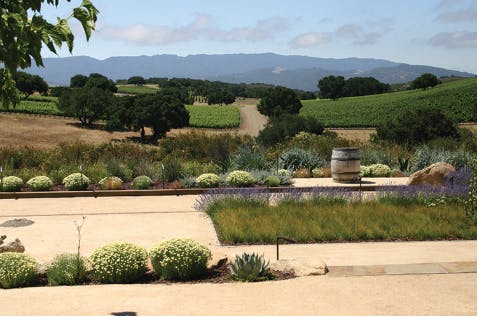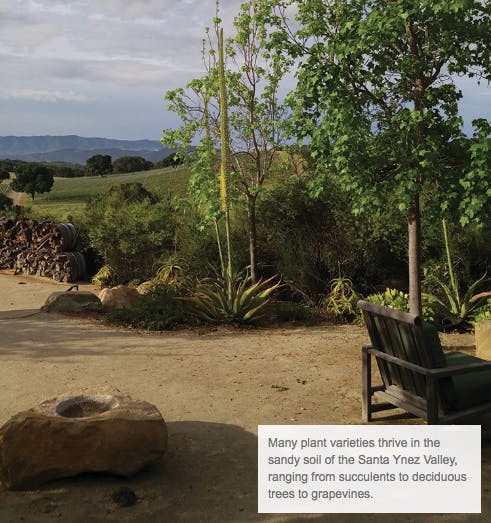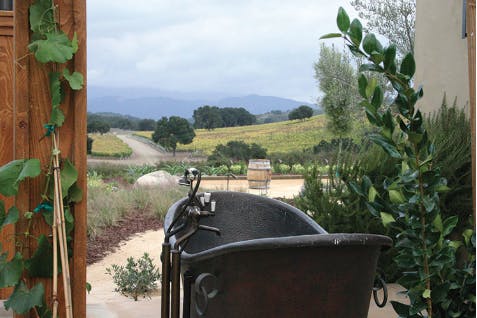A SUSTAINABLE LANDSCAPE THAT GOES WITH THE GRAPES
The dry Santa Ynez Valley of Southern California hardly seems the ideal setting for a vineyard. Yet dozens of vintners call this region home and coax award-winning vintages from the soil year after year. One of these vineyards engaged Carson Douglas Landscape Architecture to work on a project within their 600-acre farm. The firm, helmed by William Carson Joyce and Michael Douglas Brennan, has offices in San Diego, California and Edgecomb, Maine. They were asked to oversee the landscape design for an entertainment space the vineyard planned to build. The site would be used to wine and dine clientele, host tastings and parties, and even allow some guests to sleep over to enjoy the serene surroundings.
“All of our projects are site specific. We analyze each site, taking into account what’s already there, what’s valuable about the site, and what should be preserved,” explains Joyce. He felt the most valuable aspect of this property was the view. There’s something hypnotic about the serpentine rows of grapevine lined in orderly waves across the rolling farmland. The site sits above the neighboring landscape and looks over adjacent hills, vineyard, and reservoir.
Carson Douglas touts its commitment to being responsible land stewards through smart use of natural resources, native plants, and local materials. “A sustainable design is one that lasts,” says Joyce. “When you do it right the first time, it will never need to be ripped out or rebuilt. To me, that’s the most sustainable thing we can do.”
oyce knew the project shouldn’t detract from the surroundings but should instead fit in flawlessly. That required a design that included plants that could weather the harsh temperature extremes the region experiences. Temperatures can drop to 12 degrees Fahrenheit in winter and rise to 110 degrees Fahrenheit in summer. “The environmental conditions are the biggest challenge out in the valley. The temperature and soil variations limit the palette of plants you can choose from. Transforming that small palette into a beautiful environment can be quite a challenge,” says Joyce. That was a challenge the firm met head-on. Fruit-bearing trees, such as almond and olive, are dotted over the property. Oaks along the site’s outer edges were left undisturbed. Drought-tolerant plants expand the palette and include rosemary, as well as Carex and fescue grasses. Succulents like agave, aeonium, and Dudleya add varying shades of green and textures that range from spiky to smooth. Purple sage planted in large groupings adds color to the scene. On the outer edges of the site, the firm used meadow seed mixes to add greenery in a cost-effective way.
The site design also included the use of local sandstone, as well as repurposing oak barrels that had already served their function elsewhere at the winery. Some barrels store firewood for use in the fire pit while others simply add a decorative touch to the landscape or a place to rest your wineglass after a tasting. Empty wine bottles add an ornamental element to features like the island next to the outdoor kitchen.
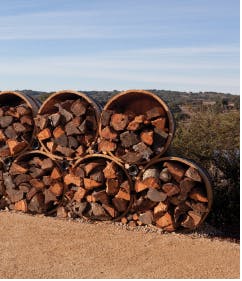
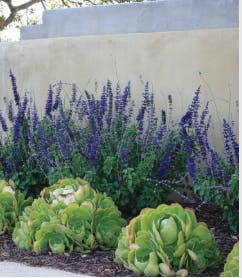
Careful plant placement ensures nothing disturbs the expansive views of the vineyard and surrounding hills. Old wine barrels, given second lives as decorative elements, offer visual reminders to visitors of where they are. Around the site, succulents soak up the sun and drip irrigation keeps perennials thriving.
Long-term care was a concern for the site owners. The vineyard team would maintain the space, yet upkeep for a garden is quite different from upkeep for a vineyard. “Our goal was to ensure the site was low maintenance, so that every time a client showed up the site looked gorgeous,” explains Joyce. A drip system irrigates the plants. Linked to weather tracking information, the automated system delivers extra water during dry spells and less during a rainy season.
Lighting served both a visual and a functional purpose. “The facility’s exterior is stucco, which creates a blank canvas that needs softening,” explains Joyce. “It also needs protection from the heat.” The firm purposely chose trees that would cast interesting shadows on the flat surface. The walls act as a living canvas as the shadows cast by the sun move across the surface. Those same shadows reappear at night as the landscape lighting takes over the sun’s role.
Guest entertainment was the purpose of this property, so the outdoor space had to be flexible enough to accommodate any crowd size or event type. “Variety was one essential consideration and mobility was the other. Seating needed to be easy to move to other areas on the site and easy to store,” explains Joyce. The Douglas fir pergola provides both shade and a defined seating area. The outdoor kitchen and wood-fired grill can serve up meals for hungry guests. The bocce ball court invites visitors to play. Low benches offer an up-close view of the garden. The fire pit makes a cozy gathering spot on a chilly desert evening. A vintage copper tub isn’t mere decoration; a water tap with a showerhead nozzle runs to the tub, which sits outside a bedroom suite and overnight guests are free to use it.
“The biggest achievement here was enhancing the view, which was already striking,” says Joyce. “That’s one of my favorite accomplishments of this project.”



